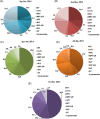Demographic and seasonal characteristics of respiratory pathogens in neonates and infants aged 0 to 12 months in the Central-East region of Tunisia
- PMID: 30351487
- PMCID: PMC6492255
- DOI: 10.1002/jmv.25347
Demographic and seasonal characteristics of respiratory pathogens in neonates and infants aged 0 to 12 months in the Central-East region of Tunisia
Abstract
Background: This study aimed to characterize the epidemiology of pathogenic respiratory agents in patients aged 0 to 12 months and hospitalized for acute respiratory infections in Tunisia between 2013 and 2014.
Methods: A total of 20 pathogens, including viruses, Mycoplasma pneumoniae, and Streptococcus pneumoniae, were detected using molecular sensitive assays, and their associations with the patient's demographic data and season were analyzed.
Results: Viral infectious agents were found in 449 (87.2%) of 515 specimens. Dual and multiple infectious agents were detected in 31.4% and 18.6% of the samples, respectively. Viral infection was predominant in the pediatric environment (90.8%, P < 0.001), male patients (88.0%), and spring (93.8%). Rhinovirus was the most detected virus (51.8%) followed by respiratory syncytial virus A/B (34.4%), coronavirus group (18.5%), adenovirus (17.9%), and parainfluenza viruses 1-4 (10.9%). Respiratory Syncytial virus A/B was significantly associated with gender (38.0% male cases vs 28.3% female cases, P = 0.02). Infections by Adenovirus, Bocavirus, and Metapneumovirus A/B increased with increasing age of patients (predominated cases aged 6-12 months, P < 0.001). S. pneumoniae was detected in 30.9% of th tested samples. In 18.2% of the negative viral infections, only S. pneumoniae was identified.
Conclusion: A predominance of the rhinovirus infection was observed in this study. Coronavirus subtypes were described for the first time in Tunisia. The observed different pathogenic profiles across age groups could be helpful to avoid the misclassification of patients presenting with ARIs at the triage level when no standardized protocol is available. This study will provide clues for physicians informing decisions regarding preventive strategies and medication in Tunisia.
Keywords: demography; infants; molecular assays; neonates; respiratory agents; seasonality.
© 2018 The Authors. Journal of Medical Virology Published by Wiley Periodicals, Inc.
Conflict of interest statement
The authors declare no conflicts of interest.
Figures

Similar articles
-
[Virus and Atypical Pathogens Detected in Community-Acquired Lower Respiratory Tract Infection in Infants and Children of Sfax Region, Tunisia].Bull Soc Pathol Exot. 2018;111(2):90-98. doi: 10.3166/bspe-2018-0024. Bull Soc Pathol Exot. 2018. PMID: 30789240 French.
-
Epidemiological and etiological characteristics of 1266 patients with severe acute respiratory infection in central China, 2018-2020: a retrospective survey.BMC Infect Dis. 2024 Apr 22;24(1):426. doi: 10.1186/s12879-024-09297-x. BMC Infect Dis. 2024. PMID: 38649799 Free PMC article.
-
[Pathogenic characteristics of hospitalized severe acute respiratory infections in Shanghai, China, 2015-2017].Zhonghua Liu Xing Bing Xue Za Zhi. 2019 Aug 10;40(8):911-916. doi: 10.3760/cma.j.issn.0254-6450.2019.08.008. Zhonghua Liu Xing Bing Xue Za Zhi. 2019. PMID: 31484253 Chinese.
-
Severe Infections Due to Respiratory Viruses.Semin Respir Crit Care Med. 2022 Feb;43(1):60-74. doi: 10.1055/s-0041-1740982. Epub 2022 Feb 16. Semin Respir Crit Care Med. 2022. PMID: 35172359 Review.
-
Emerging respiratory agents: new viruses for old diseases?J Clin Virol. 2008 Jul;42(3):233-43. doi: 10.1016/j.jcv.2008.03.002. Epub 2008 Apr 14. J Clin Virol. 2008. PMID: 18406664 Free PMC article. Review.
Cited by
-
Prevalence of Co-Infections and Pathogens in Hospitalized Children with Acute Respiratory Infections: A Comparative Analysis Between SARS-CoV-2 and Non-SARS-CoV-2 Cases.Glob Pediatr Health. 2024 Sep 12;11:2333794X241275267. doi: 10.1177/2333794X241275267. eCollection 2024. Glob Pediatr Health. 2024. PMID: 39281355 Free PMC article.
-
Molecular epidemiology of respiratory syncytial virus in children with acute respiratory illnesses in Africa: A systematic review and meta-analysis.J Glob Health. 2023 Jan 14;13:04001. doi: 10.7189/jogh.13.04001. J Glob Health. 2023. PMID: 36637855 Free PMC article.
-
Spread of Pathogens Causing Respiratory Viral Diseases Before and During CoVID-19 Pandemic in Kazakhstan.Indian J Microbiol. 2023 Mar;63(1):129-138. doi: 10.1007/s12088-023-01064-x. Epub 2023 Feb 28. Indian J Microbiol. 2023. PMID: 37168842 Free PMC article.
-
Coronavirus seasonality, respiratory infections and weather.BMC Infect Dis. 2021 Oct 26;21(1):1101. doi: 10.1186/s12879-021-06785-2. BMC Infect Dis. 2021. PMID: 34702177 Free PMC article.
-
Global Seasonality of Human Coronaviruses: A Systematic Review.Open Forum Infect Dis. 2020 Oct 18;7(11):ofaa443. doi: 10.1093/ofid/ofaa443. eCollection 2020 Nov. Open Forum Infect Dis. 2020. PMID: 33204751 Free PMC article. Review.
References
-
- Williams BG, Gouws E, Boschi‐Pinto C, Bryce J, Dye C. Estimates of world‐wide distribution of child deaths from acute respiratory infections. Lancet Infect Dis. 2002;2:25‐32. - PubMed
-
- Sinaniotis CA. Viral pneumoniae in children: incidence and aetiology. Paediatr Respir Rev. 2004;5:S197‐S200. - PubMed
Publication types
MeSH terms
Grants and funding
LinkOut - more resources
Full Text Sources
Medical

